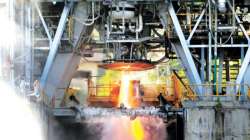The Indian Space Research Organisation (ISRO) crossed yet another milestone when it successfully tested the cryogenic engine for the heavy rocket that would launch the country's second moon mission on January 3, 2019.
In a statement on Friday, ISRO said that the cryogenic engine of the Geo Satellite Launch Vehicle (GSLV MK-III) in the upper stage was tested for the Chandrayaan-2 Mission.
The crucial test of the cryogenic engine test was conducted on Thursday for 25 seconds at ISRO’s propulsion complex in Tamil Nadu's Mahendragiri
"The upper stage of the heavy rocket is powered by cryogenic engine, which develops a nominal thrust of 186.36 kN (kilo Newton) with a specific impulse of 442 seconds in vacuum," noted the statement.
The super cooled engine operates on gas generator cycle using liquid oxygen and hydrogen (LOX & LH2) or oxidizer.
"The test demonstrated steady state operation of engine," said the statement.
The flight acceptance hot test of the cryo was performed at the high-altitude test facility in the complex.
"The performance of all engine subsystems was observed to be normal during the hot test," added the statement.
The second lunar mission will be launched from the rocketport at Sriharikota in Andhra Pradesh, about 90km northeast of Chennai, with a lander and rover a decade after the first moon mission in October 2008 around its orbit.
(With IANS inputs)
Latest India News

